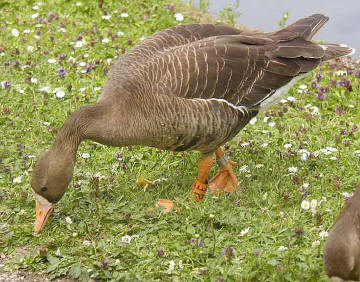Article
White Fronted Goose
Latin Name: Anser albifrons
Named because of its distinctive white band at the
base of it's bill. This is a grey goose which has two species one of which
resides and breeds in Greenland and the other in Siberia. Both species visit
Britain. Around 27,000 individuals spend the winter months in the UK. It is
sometimes referred to as the Greenland White Fronted Goose.
Identification
Greenland Species -
Adults have a large with patch at the front of their head around the beak and
bold black bars on their belly. They legs and bills are orange. The Siberia
Species are different in that their bills are pink.
|


 Details
Details
 |
|
Animal
Facts
In Britain: October-March
Life Span: Typically 6 years.
Statistics: Length 72cm, Weight 2.5kg, Wingspan 148cm.
Habitat: Tundra lakes, wet meadows on
migration flooded fields and estuaries.
Food: Grass, clover, grain, winter wheat
and potatoes.
Breeding: It does not breed in the UK. It
lays between 5-6 eggs which are incubated for around 28 days. They fledge at
40-43 days. The breed for the first time at age 3.
|
Conservation
Status

Least Concern |
Distribution: In the UK you can see them in the Severn Estuary in
Gloucestershire, the Swale Estuary - Kent, Machynlleth in Powys, as well as Ireland,
Islay Scotland where around 15,000 winter and West Scotland. You may also find them
in smaller numbers in other places throughout the UK where there are lakes,
reservoirs and large bodies of water as well as in some Wetland reserves where
captive birds are held.
Behaviour: The are solitary breeders and nest on tidal flats and upland
areas amongst tall grasses. It is primarily a grazer and feeds on grasses.
Conservation Status: Worldwide least concern, however in the UK on Amber
Status - - for an explanation
click here.
 , their habitat
needs to be protected in the UK being lost to drainage. , their habitat
needs to be protected in the UK being lost to drainage.
See Also
Winter
Migrants


Ynys Hir Nature Reserve, Machynlleth, Powys




Slimbridge WWT



BirdFacts

|